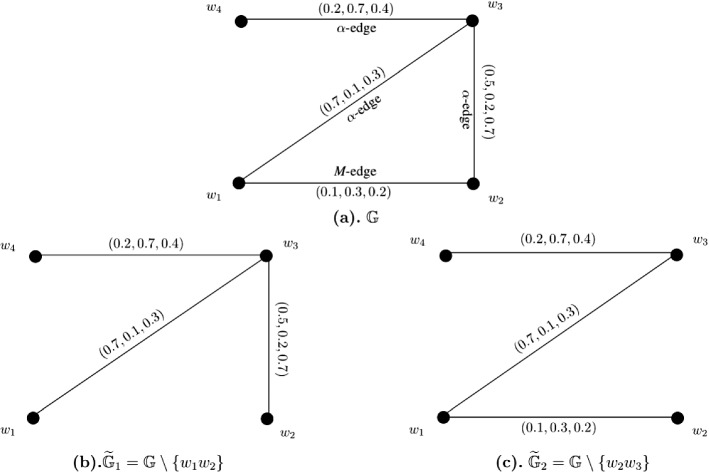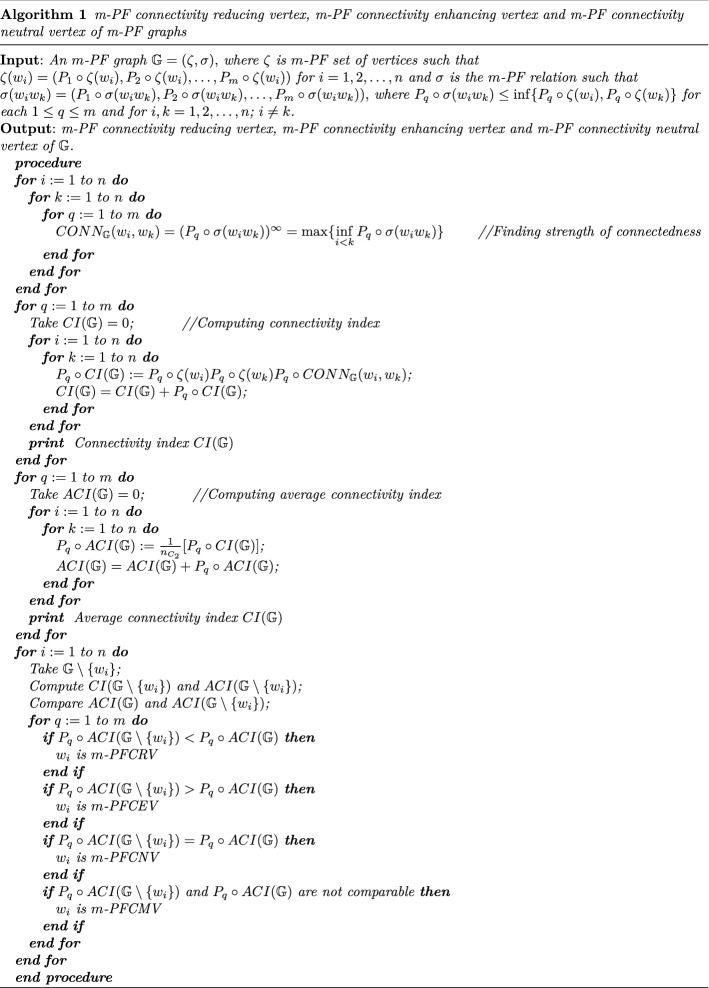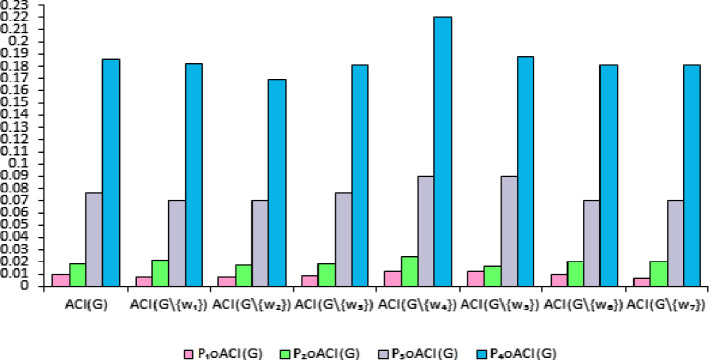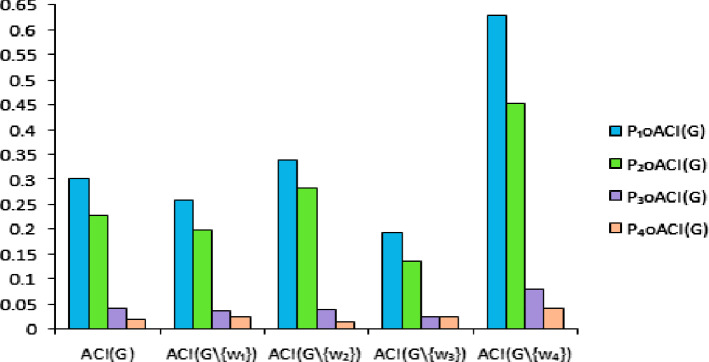Abstract
Connectivity is among the most essential concerns in graph theory and its applications. We consider this issue in a framework that stems from the combination of m-polar fuzzy set theory with graphs. We introduce two measurements of connectedness of m-polar fuzzy graphs that we call their connectivity and average connectivity indices. Examples are given, and the theoretical performance of these concepts is investigated. Particularly, we are concerned with the effect of deleting a vertex or an edge from an m-polar fuzzy graph, on its connectivity and average connectivity indices. We also establish bounding expressions for the connectivity index in complete m-polar fuzzy graphs, complete bipartite m-polar fuzzy graphs, and wheel m-polar fuzzy graphs. Moreover, we introduce some special types of vertices called m-polar fuzzy connectivity reducing vertices, m-polar fuzzy connectivity enhancing vertices, and m-polar fuzzy connectivity neutral vertices. Our theoretical contribution is applied to a product manufacturing problem that takes advantage of multi-polar uncertain information. The justification for our application is systematized using an algorithm. Finally, we compare the proposed method to existing methodologies to demonstrate its feasibility and applicability.
Keywords: Connectivity index, m-Polar fuzzy graphs, Average connectivity index, Special types of vertices.
Introduction
Zadeh (1965) extended the notion of classical subsets of a set to fuzzy sets. In order to indicate uncertainty, he looked at the fundamental concept of degree of membership in a different light. This figure was traditionally used to answer the question whether an element belongs to a subset or not: 0 holds for ‘no’ and 1 means ‘yes’. For the first time his theory allowed an object to belong to a set with a partial degree of membership within [0, 1]. Zadeh’s work (Zadeh 1965) has influenced scientists all across the world. Nowadays, many extensions of his original postulate exist. One of them owes to the view that many issues, from the micro to the macro scale, tend to multi-polarity. As a result, it is no surprise that multi-polarity in information and data collection has gained popularity in many basic and technological disciplines. In neurobiology, for example, multi-polar neurons in the brain collect a lot of information from other neurons. Multi-polar technology may be used to manage large-scale systems in information technology. Bearing this fact in mind, and motivated by the concept of bipolar fuzzy sets (Zhang 1994), Chen et al. (2014) presented the notion of m-polar fuzzy (m-PF, in short) set as an extension of fuzzy set. The assessment of the membership of an element with m different qualities in an m-PF set lies in , and this assessment captures all its separate memberships. This approach is better suited to model a variety of real-world uncertain situations, like the case of data originating with several agents or informational sources. The influence of Zadeh’s paradigm shift extended to graph theory, which is concerned with the relationships among a set of objects under consideration. Its applications demand a precise inspection of technically sound ideas, like those related to connectivity. For example, suppose that we have various routers in a network, then the maximum possible value of the strength of connectedness between two routers is essential to keep its reliability and effectiveness. Also, the only way to confirm the stability of a flow in a piece of the network, or in the entire network, is to measure the average flow in that area. But uncertain relationships abound and they are better captured by fuzzy models. For this reason Kaufmann (1973) set forth the fundamentals of fuzzy graphs. Whereas the strength of connectedness between any two vertices is either 0 or 1 in a graph, it is allowed to be in the range [0, 1] in a fuzzy graph. Connectivity became a decisive concept in fuzzy graph theory too. An issue that demonstrates the importance of connectivity in fuzzy graphs is the fact that total flow disconnection occurs less frequently in physical problems (such as network problems) than flow reduction between pairs of vertices.
Many authors were quick to expand the new theory further. Rosenfeld (1975) investigated fuzzy relations. He studied fuzzy analogues of several basic graph-theoretical notions like cycles and paths, connectedness, bridges and trees. In fact, it was Rosenfeld (1975) who first developed a comprehensive theory of fuzzy graphs, although Yeh and Bang (1975) had independently proposed fuzzy graphs. In addition, they introduced several parameters to assess connectivity in a fuzzy graph, and investigated their applications. Early contributions to the theoretical basis of fuzzy graph theory abound. For example, Mordeson and Nair (2000) presented other operations on fuzzy graphs. Bhattacharya (1987) defined certain concepts of connectivity concerning fuzzy bridges and fuzzy cut-vertices. Bhattacharya and Suraweera (1991) established procedures for the computation of connectivity between pairs of vertices in fuzzy graphs. Banerjee (1991) studied an optimal algorithm for calculating the strength of connectedness in fuzzy graphs, and also Tong and Zheng (1996) developed an algorithm for the calculation of the connectivity matrix of a fuzzy graph. In their analysis of fuzzy graphs, Bhutani and Rosenfeld (2003) established the notions of strong paths and arcs. Mathew and Sunitha (2009) classified distinct types of arcs in fuzzy graphs and developed an arc identification algorithm. A sufficient condition for a node to be a fuzzy cut-node was given in Mathew and Sunitha (2009). Applications and extensions soon appeared as well. Xu (1997) utilized fuzzy graph connectivity parameters to problems involving chemical structures. Binu et al. (2019) examined the connectivity index of fuzzy graphs with application to human trafficking. In the analysis of bipolar fuzzy graphs (Akram 2011), Poulik and Ghorai (2020) introduced certain indices and produced related applications. Recently, Gong et al. (2021) studied domination of bipolar fuzzy graphs. Akram and Waseem (2016) established the concept of m-PF graphs in order to study network models with multi-polar, multi-attribute information. Various authors presented additional notions, inclusive of various types of edge m-PF graphs (Akram et al. 2017), m-PF graph structures (Akram et al. 2016), faces and dual of m-PF graphs (Ghorai and Pal 2016a), m-PF labeling graphs (Akram and Adeel 2016), fuzzy coloring of m-PF graphs (Mahapatra and Pal 2018), and applications of m-PF graphs in decision support systems (Akram and Sarwar 2017). The strength of connectedness between vertices has been recently studied in an m-PF graph (Mandal et al. 2018; Akram et al. 2021). Mandal et al. (2018) have discussed other fundamental concepts like strong and strongest m-PF path, m-PF bridge, and m-PF forests. Other types of edges in m-PF graphs were introduced in Akram et al. (2021). For other concepts, the readers are suggested to Chen (1997), Mahapatra and Pal (2022), Mahapatra et al. (2021), Samanta and Pal (2015), Gao et al. (2022a, b), Habib et al. (2022), and Akram and Nawaz (2022). To summarize, Table 1 presents a brief comparison of works that have used different strategies to develop novel algorithms related to connectivity of graphs.
Table 1.
Summary of contributions to the study of connectivity of graphs in related literature
| Authors and dates | Methodology | Contributions |
|---|---|---|
| Mathew and Sunitha (2013) | Cycle connectivity in FGs | 1. Proposed the concepts of cycle connectivity of fuzzy trees, fuzzy cycles and complete FGs |
| 2. Introduced the notions of cyclic cut nodes and cyclic bridges in FGs | ||
| Jicy and Mathew (2015) | Connectivity analysis of cyclically balanced FGs | 1. Discussed cyclic cut vertices, cyclic bridges and cyclically balanced FGs |
| 2. Obtained the characterization of cyclically balanced FGs | ||
| Ali et al. (2018) | Vertex connectivity of FGs and human trafficking | 1. Constructed t-connected FGs and average fuzzy vertex connectivity of FGs |
| 2. Presented the concept of uniformly t-connected fuzzy graph | ||
| Binu et al. (2019) | Connectivity index of FGs and human trafficking | 1. Determined the stability of FGs by the strength of connectedness between each pair of nodes |
| 2. Introduced two measures namely, connectivity index and average connectivity index of FGs | ||
| Poulik and Ghorai (2020) | Certain connectivity indices of bipolar FGs | 1. Presented the boundedness of connectivity index of a bipolar FGs |
| 2. Investigated the changes of connectivity index when a vertex or an edge is removed | ||
| 3. Applied the results to increase the popularity of women football league in India and to determine the order of the places to build colleges in a town | ||
| Binu et al. (2021) | Connectivity status of fuzzy graphs | 1. Adopted connectivity status to build up the status sequence related to FGs |
| 2. Obtained the results on connectivity status and status sequence of different structures of FGs | ||
| Akram et al. (2021) | Menger’s theorem for m-PF graphs | 1. Classified different types of m-PF edges in an mPF graph by using the strength of connectedness |
| 2. Identified different types of m-PF edges, including -strong m-PF edges, -strong m-PF edges and -weak m-PF edges | ||
| Naeem et al. (2021) | Connectivity indices of intuitionistic FGs | 1. Defined connectivity and average connectivity index for intuitionistic FGs |
| 2. Described certain kinds of nodes including, connectivity enhancing node, connectivity reducing node and connectivity neutral node for intuitionistic FGs |
Motivation and contributions
Connectivity is the most intuitive attribute to relate with a network. For example, when we have numerous routers on the internet, the maximum possible value of the strength of connectedness between two routers is an essential proxy to guarantee that the network is reliable and effective. Also, the only way to confirm the stability of a flow in a piece of the network or in the entire network is to measure the average flow in that area. The proposed formulation is motivated by the following interests:
Our main motivation is the lack of a systematic investigation of connectivity in the graph theory generated from multi-polar uncertain information. This is a critical issue that characterizes many real-world decision-making situations.
Fuzzy and bipolar fuzzy graph models have been successfully employed to manage uncertain information. However both models require further adjustments of membership functions and a great deal of background knowledge.
Achieving our goal will enable us to enhance the methods described in Binu et al. (2019) and Poulik and Ghorai (2020) which, through their examination of the fuzzy and bipolar fuzzy graph models, have paved the way for decision analysis based on connectivity with fuzzy information.
In practical applications, the uncertainties in network parameters derived from multi-polar information are far from obvious. Consider for example the case of governments that must decide to implement a smart lockdown during the COVID-19 pandemic. There are many aspects to consider, including the availability of health facilities, testing facilities, public awareness, local rates of transmission, the local community’s reaction to the pandemic, etc. Most of these factors are uncertain in nature. This type of multi-polar uncertain information cannot be correctly handled with the help of fuzzy or bipolar fuzzy graph models. It is thus convenient to pay more attention to connectivity analysis of graphs in the context of m-PF graphs.
Motivated by the factors above, our work is devoted to present an extended version of connectivity indices of fuzzy graphs that perform well under multi-polar human assessments. In the current study, we reformulate this method for m-PF graphs. The following bullet points encapsulate the innovative contributions of our research work:
To help studying real-world multi-polar uncertain problems, our research produces two measures of connectedness (connectivity and average connectivity index) for m-PF graphs.
Our study investigates the effects on both connectivity indices of the elimination of a vertex or an edge from an m-PF graph.
We establish bounds of the connectivity index in complete m-PF graphs, complete bipartite m-PF graphs, wheel m-PF graphs. Also, we introduce some special types of vertices, namely, m-PF connectivity reducing vertices, m-PF connectivity enhancing vertices, and m-PF connectivity neutral vertices.
These new tools are applied to a problem of selection of optimal products to be manufactured by a multinational enterprise.
A comparison among the fuzzy, bipolar fuzzy, and m-PF graph models (through the problem of finding the set of representatives for a youth development council in a university) is also given to prove the flexibility and validity of our new technical contribution.
Outline of the paper
The content of this paper is organized as follows. Section 2 deals with some basic terminologies and results related to this research work. In Section 3, we define the connectivity index of an m-PF graph and use it to prove several theorems on m-PF subgraphs. Section 4 deals with bounds for the connectivity index of certain m-PF graphs, including complete m-PF graphs, complete bipartite m-PF graphs and wheel m-PF graphs. In Section 5, we discuss the connectivity index of edge-deleted m-PF subgraphs of m-PF graphs. In Section 6, we define the average connectivity index of an m-PF graph and introduce some special types of vertices of m-PF graphs using this concept. Section 7 deals with the application of connectivity and average connectivity index of m-PF graphs for the selection of products to be manufactured by a company. This section also includes an algorithm to clearly understand the general procedure supporting our application. In Section 8, a comparison of our technique with existing techniques is shown to exhibit the practicality and generality of the method suggested in this paper. Section 9 summarizes the findings, benefits and limitations of our research. The last section 10 concerns conclusions and future directions for research.
Preliminaries
The concept of m-PF set on W, a non-empty set, was defined in Chen et al. (2014) as a function . The collection of all m-PF sets on W is represented by m(W). Observe that the set can be endowed with a partially ordered set (or poset) structure if we resort to the point-wise order defined by the expression , where . Here, represents the standard q-th projection mapping for every .
Definition 1
(Akram and Waseem 2016) Suppose that is an m-PF set on W. Then an m-PF relation on is , a mapping satisfying that if we write down , then for each ,
for each , where and represent the q-th membership value of vertex w and edge wz, respectively. We say that on W is symmetric when for each , where .
Definition 2
(Akram and Waseem 2016) An m-PF graph on W consists of an ordered pair of mappings , where is an m-PF set on W and is an m-PF relation on W, in a such way that for each ,
for each and for all , . Note that and are the largest and smallest element of the partial order in , respectively.
Definition 3
(Mandal et al. 2018) Consider an m-PF graph . An m-PF graph is a partial m-PF subgraph of when for each , it is the case that for all and for all . Particularly, a partial m-PF subgraph an m-PF subgraph of if for each , for all and for all . An m-PF subgraph spans the m-PF graph if for each , for all , i.e., and for all .
Definition 4
(Akram and Waseem 2016) Consider an m-PF graph . An m-PF path P in consists of a sequence of different vertices such that there exists at least one for each satisfying . An m-PF path between two vertices and is said to be an m-PF cycle C (Akram et al. 2021) if and . The strength of an m-PF path P is described as . The strength of connectedness between two vertices and () is the maximum of the strengths of all m-PF paths between and . Mathematically, it is defined as , where . An m-PF path is defined to be a strongest m-PF path if . An m-PF graph is connected if there exists an m-PF path between each pair of vertices, i.e., for at least one q.
In the rest of this paper, we suppose that the m-PF graph is connected.
Definition 5
(Mandal et al. 2018) A connected m-PF graph is an m-PF tree if it has an m-PF spanning subgraph which is a tree and for each edge wz not in there exists an m-PF path from w to z in whose strength is greater than the membership value of edge wz in , i.e., for each .
Note that is a tree such that it contains all the vertices of , therefore, it is in fact a spanning tree of . Yet more, has no other maximum spanning tree.
Definition 6
(Akram and Waseem 2016) An m-PF graph is a strong m-PF graph when for all , for each . We say that the m-PF graph is complete when for all , for each .
Definition 7
(Akram et al. 2021) An m-PF graph is a bipartite m-PF graph if () such that (i). for each , if or , (ii). for at least one q, if and or and .
Definition 8
(Akram et al. 2021) We say that the m-PF graph is a complete bipartite m-PF graph when () such that (i). for each , if or , (ii). for each , if and or and .
Definition 9
(Akram et al. 2021) Suppose that is an m-PF graph. We say that the edge is a strong m-PF edge of when , for each . The vertices w and z, incident to a strong m-PF edge, are strong m-PF neighbors when for each . An m-PF path P between w and z is strong when all edges contributing to the path are strong.
A strong m-PF edge is called an -strong m-PF edge (-edge) if for each , . A strong m-PF edge is called a -strong m-PF edge (-edge) if for each , . An edge is a weak m-PF edge of if it is not strong m-PF edge of . A weak m-PF edge wz is -weak (or a -edge) if for each , . Otherwise, we say that it is a mixed m-PF edge (-edge) of .
Definition 10
(Akram et al. 2021) Let be an m-PF graph. We say that the edge is an m-PF bridge of when we get a partial m-PF subgraph by replacing in which for each , either or for some pair of vertices u and v of .
Definition 11
(Akram et al. 2021) Suppose that is an m-PF graph. We say that the edge is a weakest m-PF edge of , when for each , for any edge other than ab. And the edge is a strongest m-PF edge of , when for each , for any edge other than cd.
Definition 12
(Ghorai and Pal 2016b) Let and be two m-PF graphs of the crisp graphs and , respectively.
If there exists a mapping such that for each , for all and for all , then the mapping is called a homomorphism between and .
If there is a bijective map with the property that for each , for all and for all , then the mapping is called an isomorphism between and .
Connectivity index of an m-PF graph
Connectivity is the most intuitive attribute to relate with a network. For instance, when we have many routers in a network, the maximum possible value of the strength of connectedness between two routers is essential to keep the network more reliable and effective. In this section, we first define the connectivity index of an m-PF graph , we then prove several theorems on m-PF subgraphs using the connectivity index of . The definition of connectivity index of an m-PF graph is given below:
Definition 13
Let be an m-PF graph. The connectivity index of is denoted by and is defined as , where for each .
Note that, unless otherwise mentioned, the considered examples of m-PF graphs in the following sections will have for each , for all .
Example 1
Let be a vertex set and be the set of edges. The corresponding 3-PF graph is given in Fig. 1 with for all . Consider two vertices and . The 3-PF paths from to with their corresponding strengths are given below:
: ,
: ,
: ,
: .
The strength of connectedness between and is . Similarly, the strength of connectedness between all pairs of vertices of are calculated in the following connectivity matrix (1). Since, for all and connectivity matrix of is symmetric, therefore, the can be obtained by taking the summation of all entries in the lower or upper triangular entries of this connectivity matrix. After calculations, we have .
| 1 |
Fig. 1.

3-PF graph
In general, m-PF subgraphs will have fewer connections than the m-PF graph and their connectivity indices will never be higher. As a result, we arrive to the following proposition.
Proposition 1
Let be an m-PF graph and be a partial m-PF subgraph of . Then for each , , that is, will be less than or equal to .
Proof
Let be an m-PF graph and be a partial m-PF subgraph of . Then it is clear that for each , and for all and . This implies that for each , for all . Since, for each , and for all and for all , respectively. Therefore, for each , . This means that for each , . Thus, for each , . This shows that can never exceed .
Note that Proposition 1 holds true for m-PF subgraphs of an m-PF graph as every m-PF subgraph of is a partial m-PF subgraph. Consider the following example.
Example 2
Let be a vertex set and be the set of edges. The 3-PF graph associated with this data is shown in Fig. 2 with for all . Clearly, it is a 3-PF subgraph of the 3-PF graph in Example 1 (Fig. 1). The strength of connectedness between all pairs of vertices of are calculated in the connectivity matrix (2). After calculations, we have .
| 2 |
Fig. 2.

3-PF graph
Proposition 2
Let be an m-PF graph and be an m-PF subgraph of . Then for each , , that is, will be less than or equal to .
We now discuss several particular cases of Proposition 1.
1 Let be an m-PF graph, and let be a partial m-PF subgraph of that stems from the elimination of a vertex (say w) from , i.e., . Then for each , , that is, will be strictly less than . Consider the following example.
Example 3
Let be a vertex set and be the set of edges. The corresponding 3-PF graph is given in Fig. 3a with for all . The strength of connectedness between all pairs of vertices of are calculated in the following connectivity matrix (3). After calculations, we have . Now, consider a partial 3-PF subgraph (given in Fig. 3b) of such that it is obtained after deleting vertex from , i.e., . The strength of connectedness between all pairs of vertices of are calculated in the connectivity matrix (4). Some computations produce . Clearly, for each , , that is to say, is strictly smaller than .
| 3 |
| 4 |
Fig. 3.

3-PF graph and partial 3-PF subgraph of
2 Let be an m-PF graph whose crisp underlying graph is a cycle with wz as a weakest m-PF of and be a partial m-PF subgraph of such that it is obtained by deleting edge wz from , i.e., . Then for each , , that is, will be equal to . Consider the following example.
Example 4
Let be a vertex set and be the set of edges. The corresponding 3-PF graph is given in Fig. 4a with for all . The strength of connectedness between all pairs of vertices of are calculated in the following connectivity matrix (5). After calculations, we have . Now, consider a partial 3-PF subgraph (given in Fig. 4b) of such that it is obtained after deleting edge from , i.e., ( is the weakest 3-PF of ). The strength of connectedness between all pairs of vertices of are calculated in the following connectivity matrix (6). After calculations, we have . Clearly, for each , , that is, is equal to .
| 5 |
| 6 |
Fig. 4.

3-PF graph and partial 3-PF subgraph of
Theorem 1
Let and be two homomorphic m-PF graphs. Then for each , , that is, will be less than or equal to .
Proof
Let and be two homomorphic m-PF graphs. Then there exists a mapping such that for each , for all and for all . Also, the homomorphism between and implies that the strength of any strongest path between any two vertices w and z in is less than or equal to that between and in . Therefore, we have for each , for all . This implies that for each , . This implies that for each , . Thus, is less than or equal to .
If and are isomorphic to each other, the equality between and holds. The connectivity indices of two isomorphic m-PF graphs are described by the following theorem.
Theorem 2
Let and be two isomorphic m-PF graphs. Then for each , , that is, will be equal to .
Proof
Let and be two isomorphic m-PF graphs. Then there exists a bijective mapping such that for each , for all and for all . Also, the isomorphism between and implies that the strength of any strongest path between any two vertices w and z in is equal to that between and in . Therefore, we have for each , for all . This implies that for each , . This implies that for each , . Thus, equals .
Bounds for the connectivity index of m-PF graphs
We now describe several bounds for the connectivity index of m-PF graphs in this section. Also, we examine the connectivity index of a complete m-PF graph by various theorems. The complete m-PF graph will have the maximum connectivity among all m-PF graphs on a fixed support (having the same vertex set), as shown in the next result.
Theorem 3
Let be an m-PF graph with . If is the completion of spanned by its vertex set, then for each , .
Proof
Let be an m-PF graph with and be the completion of spanned by its vertex set, i.e., and for each . We have three cases as follows:
Case 1 If is a trivial m-PF graph () with and . Then its completion is also a trivial m-PF graph. Obviously, for each , .
Case 2 If is a trivial m-PF graph () with and . Then for each , for all pairs of vertices of . This means that for each , . Since, is the completion of spanned by its vertex set, therefore, for each , for all pairs of vertices of . This shows that for each , . Thus, for each , .
Case 3 If is a non-trivial m-PF graph () with . Then for each , for all . This implies that for each , . Since, is the completion of spanned by its vertex set, therefore, for each , for all . This implies that for each , for all . Hence, for each , .
Thus, in all cases for each , holds true.
Theorem 4
Let be a complete m-PF graph with such that for and for each . Then for each .
Proof
Let be a complete m-PF graph with such that for and for each . It is obvious that is the vertex of such that for and for each , i.e., is of least membership value. Also, in complete m-PF graph for all and for each . This implies that and for and for each . Now, consider for each . Consider for and . Since, is of least membership value and is complete m-PF graph. Therefore, for each . Taking summation over k, we have
| 7 |
for each . Consider for and (). Since, and is complete m-PF graph. Therefore, for each . Taking summation over i and k, we have
| 8 |
for each . Adding Eqs. 7 and 8, we have
for each . By combining both terms on R.H.S. of above equation, we have
for each . This completes the proof.
Example 5
Let be a vertex set and be the set of edges. The corresponding 3-PF graph is given in Fig. 5 with , , , and . Clearly, is a complete 3-PF graph satisfying for and for each .
Fig. 5.
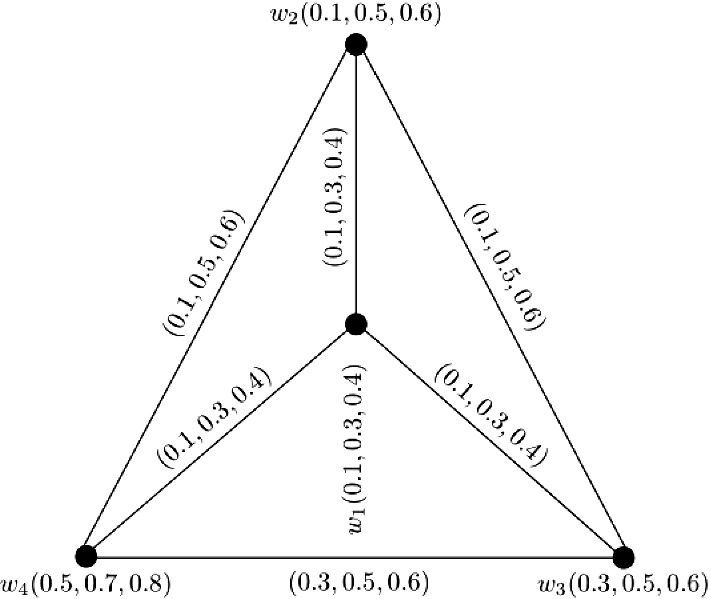
Complete 3-PF graph
Therefore, we can calculate by using Theorem 4 as
Here,
Similarly, we obtain and . After calculations, we have
Note that for each implies for . Therefore, if a complete m-PF graph does not satisfy the condition for each , then Theorem 4 need not be true.
Theorem 5
Let be a complete bipartite m-PF graph with . Also, let and such that for and for each . Then for each .
Proof
Let be a complete bipartite m-PF graph with . Also, let and such that for and for each . It is obvious that is the vertex of such that for and for each , i.e., is of least membership value. Since, is a complete m-PF graph. This implies that for each , if or , and for each , if and or and . Now, consider for each . Consider for and . Since, is of least membership value and is complete bipartite m-PF graph. Therefore, for each . Taking summation over k, we have
| 9 |
for each . Consider for and (). Since, and is complete bipartite m-PFG. Therefore, for each . Taking summation over i and k, we have
| 10 |
for each . Consider for () and (). Since, and is complete bipartite m-PF graph. Therefore, . Taking summation over i and k, we have
| 11 |
for each . Adding Eqs. 9, 10 and 11, we have
for each . By combining first two terms on R.H.S. of above equation, we have
for each . This completes the proof.
Example 6
Let be a vertex set and be the set of edges. The corresponding 3-PF graph is given in Fig. 6 with , , , , and . Clearly, is a complete bipartite 3-PF graph satisfying for and for each .
Fig. 6.
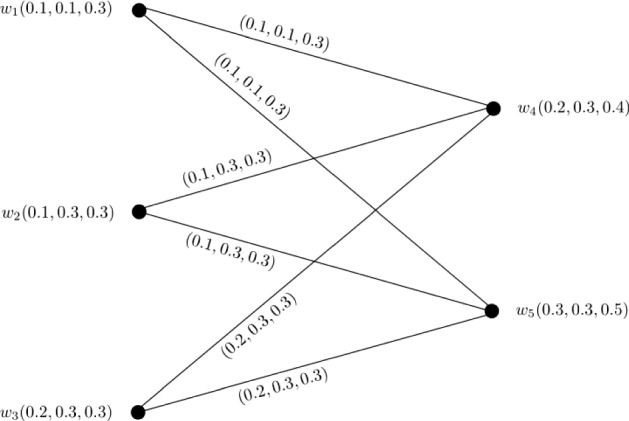
Complete bipartite 3-PF graph
Therefore, we can calculate by using Theorem 5 as
Here,
Similarly, we obtain and . After calculations, we have
Theorem 6
Let be a wheel m-PF graph with such that for and for each . Also, let be the center vertex of and for any edge , for each . Then for each .
Proof
Let be a wheel m-PF graph with such that for and for each . Also, let be the center vertex of and for any edge , for each . It is obvious that is the vertex of such that for and for each , i.e., is of least membership value. Now, consider for each . Consider for and . Since, is of least membership value and for any edge , for each . Therefore, for each . Taking summation over k, we have
| 12 |
for each . Consider for and (). Since, and for any edge , for each . Therefore, for each . Taking summation over i and k, we have
| 13 |
for each . Adding Eqs. (12) and (13) together, we have
for each . By combining both terms on R.H.S. of above equation, we have
for each . This completes the proof.
Example 7
Let be a vertex set and be the set of edges. The corresponding 3-PF graph is given in Fig. 7 with , , , , and . Clearly, is a wheel 3-PF graph satisfying for and for each .
Fig. 7.
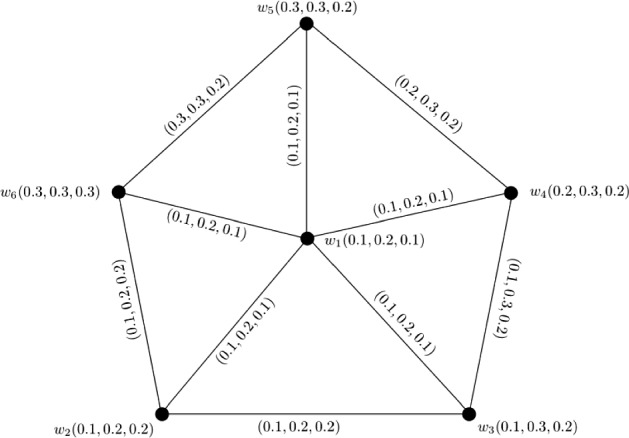
Wheel 3-PF graph
Therefore, we can calculate by using Theorem 6 as
Here,
Similarly, we obtain and . After calculations, we have
Connectivity index of edge-deleted m-PF subgraphs
We observed that the elimination of a vertex w from an m-PF graph produces a new m-PF subgraph whose connectivity index is smaller. This was presented as the particular case 1 of Proposition 1. However, the connectivity index of edge-deleted m-PF subgraphs of an m-PF graph depends on the nature the deleted edge. It may remain same or reduce. In this section, we examine the connectivity index of edge-deleted m-PF subgraphs of an m-PF graph. Consider the following examples.
Example 8
Let be a vertex set and be the set of edges. The corresponding 3-PF graph is given in Fig. 8a with for all . The strength of connectedness between all pairs of vertices of are calculated in the following connectivity matrix (14). After calculations, we have . Now, consider edge-deleted 3-PF subgraphs (given in Fig. 8b) and (given in Fig. 8c) of . The strength of connectedness between all pairs of vertices of and are calculated in the connectivity matrices respectively shown by Eqs. (15) and (16). Some computations produce and .
| 14 |
| 15 |
| 16 |
Fig. 8.
3-PF graph , edge-deleted 3-PF subgraphs and of
Example 9
Let be a vertex set and be the set of edges. The corresponding 3-PF graph is given in Fig. 9a with for all . The strength of connectedness between all pairs of vertices of are calculated in the following connectivity matrix (17). After calculations, we have . Now, consider edge-deleted 3-PF subgraphs (given in Fig. 9b) and (given in Fig. 9c) of . The strength of connectedness between all pairs of vertices of and are calculated in the connectivity matrices respectively shown in Eqs. (18) and (19). After calculations, we have and .
| 17 |
| 18 |
| 19 |
Fig. 9.
3-PF graph , edge-deleted 3-PF subgraphs and of
Example 10
Let be a vertex set and be the set of edges. The corresponding 3-PF graph is given in Fig. 10a with for all . The strength of connectedness between all pairs of vertices of are calculated in the connectivity matrix shown in Eq. (20). After calculations, we have . Now, consider edge-deleted 3-PF subgraphs (given in Fig. 10b) and (given in Fig. 10c) of . The strength of connectedness between all pairs of vertices of and are calculated in the connectivity matrices respectively shown in Eqs. (21) and (22), respectively. After calculations, we have and .
| 20 |
| 21 |
| 22 |
Fig. 10.
3-PF graph , edge-deleted 3-PF subgraphs and of
We observed in Example 8, Example 9, and Example 10 that the removal of distinct edges effects the connectivity index of an m-PF graph differently. Therefore, we have several results for characterizing the connectivity index of as a consequence of this.
Theorem 7
Let be an m-PF graph and be the m-PF subgraph of obtained after deleting an edge from . Then for each , if and only if wz is an m-PF bridge of .
Proof
Let be an m-PF graph and be the m-PF subgraph of obtained after deleting an edge from . First, suppose that edge wz be an m-PF bridge of . This implies that for each , either or for some pair of vertices u and v of . This implies that for each , . Taking summation on both sides implies that for each , . This implies that for each , . Conversely, suppose that for each , . To prove that edge yz is an m-PF bridge of , consider the following three cases:
Case 1 Let wz be a -edge. This means that for each , for all pairs of vertices u and v of . This implies that for each , . Taking summation on both sides implies that for each , . This implies that for each , . This contradicts to our supposition.
Case 2 Let wz be a -edge. This means that for each , . This implies that there exists an alternate strongest m-PF path between vertices w and z in other than the edge wz in . This means that the deletion of edge wz does not effect the strength of connectedness between any pair of vertices of (since, is a connected m-PF graph). This implies that for each , . This shows that for each , . Taking summation on both sides implies that for each , . This implies that for each , . This again contradicts to our supposition.
Case 3 Let wz be an -edge. This means that for each , . This implies that edge wz is the unique strongest m-PF path between vertices w and z in . This means that for each , . This implies that for each , . Taking summation on both sides implies that for each , . This implies that for each , . Since, -edges are m-PF bridges of . Therefore, wz is an m-PF bridge of . Thus, it is proved that for each , if and only if wz is an m-PF bridge of .
Corollary 1
Let be an m-PF graph and be the m-PF subgraph of . Then for each , if and only if wz is either -edge or -edge.
For illustration of Corollary 1, consider Example 8. Since, edge is a -edge of , therefore its deletion does not effect the connectivity index of , i.e., . Now, consider Example 9. Since, edge is a -edge of , therefore its deletion does not effect the connectivity index of , i.e., .
Remark 1
A complete m-PF graph has at most one m-PF bridge.
Example 11
Consider the complete 3-PF graph in Fig. 5 of Example 5. Here, edge is the only -edge of . This means that has only one 3-PF bridge, namely . The rest of the edges are -edges.
Theorem 8
Let be an m-PF graph and be the m-PF subgraph of . Then for each , if and only if wz is the unique m-PF bridge of .
Proof
Let be an m-PF graph and be the m-PF subgraph of . First, suppose that for each , . Since, is a complete m-PF graph, therefore by Remark 1, wz is the unique m-PF bridge of . Conversely, suppose that wz is the unique m-PF bridge of . Then by Theorem 7, for each , . This implies that for each , . Thus, it is proved that for each , if and only if wz is the unique m-PF bridge of .
Average connectivity index of an m-PF graph
The only way to assure the stability of a flow in a piece of the network or in the whole network is to measure the average flow in that area. In order to achieve this goal, we present the average connectivity index of m-PF graphs in this section. The definition of average connectivity index of an m-PF graph is as follows.
Definition 14
Let be an m-PF graph. The average connectivity index of is denoted by and is defined as , where for each . Simply, we can say that an is obtained by dividing the by total number of pairs of vertices () of , that is, . Also, for each , .
Example 12
Consider the 3-PF graph in Fig. 1 of Example 1. Here, and . After dividing by 10, we have .
We observed in case 1 of Proposition 1 that the deletion of a vertex from an m-PF graph reduces the . But how does deleting a vertex from a m-PF graph effect the ? To observe the effect look at the following example.
Example 13
Let be a vertex set and be the set of edges. The corresponding 3-PF graph is given in Fig. 11 with for all . The strength of connectedness between all pairs of vertices of are calculated in the following connectivity matrix (23). Here, . After calculations, we have and . , , , . Clearly, the deletion of vertices and reduces the whereas the deletion of vertices and enhances the . The effect of deletion of different vertices on is shown in Table 2.
| 23 |
Fig. 11.
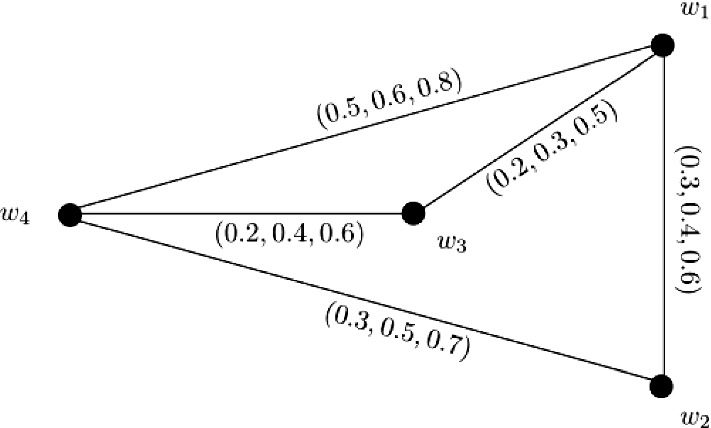
3-PF graph
Table 2.
Effect on after deleting a vertex from
| Effect | |||
|---|---|---|---|
| (0.7, 1.3, 1.9) | (0.233, 0.433, 0.633) | ||
| (0.9, 1.4, 2.0) | (0.300, 0.467, 0.67) | ||
| (1.1, 1.6, 2.2) | (0.367, 0.533, 0.733) | ||
| (0.7, 1.0, 1.6) | (0.233, 0.333, 0.533) |
We observed in Example 13 that the deletion of some vertices reduces the average connectivity index of m-PF graph, while the deletion of some vertices enhances the average connectivity index of m-PF graph. There may be some vertices in m-PF graph whose deletion does not effect the its average connectivity index. As a result, we have the following definition for characterizing the vertices of an m-PF graph using the .
Definition 15
Let be an m-PF graph and . Then w is called an m-PF connectivity reducing vertex (m-PFCRV) or an m-PF connectivity enhancing vertex (m-PFCEV) or an m-PF connectivity neutral vertex (m-PFCNV) if for each , either or or , respectively. Otherwise, it is said to be an m-PF connectivity mixed vertex (m-PFCMV).
Consider the 3-PF graph in Fig. 11 of Example 13, here are m-PFCRVs and are m-PFCEVs. We now characterize these vertices based on connectivity index of m-PFG in the following theorem.
Theorem 9
Let be an m-PF graph with . Also, let for each and . Then w is said to be an
-
(i)
m-PFCRV if and only if for each .
-
(ii)
m-PFCEV if and only if for each .
-
(iii)
m-PFCNV if and only if for each .
Proof
Let be an m-PF graph with . Suppose that for each and . (i). Let w be an m-PFCRV. By Definition 15, for each . for each . for each . for each . Similarly, (ii) and (iii) can be proved.
Definition 16
Let be an m-PF graph. Then is said to be a connectivity reducing m-PF graph if it contains at least one m-PFCRV. is said to be a connectivity enhancing m-PF graph if it contains at least one m-PFCEV. is said to be a connectivity neutral m-PF graph if it contains at least one m-PFCNV. Otherwise, it is said to be a connectivity mixed m-PF graph.
Example 14
Consider the 3-PF graph in Fig. 11 of Example 13. Here, contains two m-PFCRVs, namely and , therefore it is a connectivity reducing m-PF graph. Also, contains two m-PFCEVs, namely and , therefore it is a connectivity enhancing m-PF graph. However, contains no m-PFCNV, therefore it is not a connectivity neutral m-PF graph.
Theorem 10
Let be an m-PF graph with . Also, let for each and w is an end vertex of . Then w is said to be an
-
(i).
m-PFCRV if and only if for each .
-
(ii).
m-PFCEV if and only if for each .
-
(iii).
m-PFCNV if and only if for each .
Proof
Let be an m-PF graph with . Also, let for each and w is an end vertex of . (i). First, suppose that w be an m-PFCRV. Note that for each . for each . for each . Since, w is an m-PFCRV, therefore by Theorem 9, for each . for each . Conversely, suppose that for each . Note that for each . for each . for each . for each . By Definition 14, for each . for each . for each . Hence, w is an m-PFCRV. Thus, we proved that w is an m-PFCRV if and only if for each . Similarly, (ii) and (iii) can be proved.
Below is a general description of the algorithm for calculating different connectivity indices of m-PF networks. Its pseudocode presentation is provided in Algorithm 1.
Description and Complexity of the Algorithm At the initial stage, the algorithm calculates the strength of connectedness between all pair of nodes, therefore, the time complexity of these nested ‘for’ loops is where n is the total number of nodes in The next set of nested loops computes connectivity index of m-PF graphs. Its time complexity is The next stage involves the evaluation of the average connectivity index of m-PF graphs. The running time of these nested loops is the same as previous one. The next for loop runs m times, therefore its complexity is O(m). The comparison of different connectivity indices for m-PF graphs is then calculated. The running time of all these ‘if’ conditionals is O(m). This comparison helps to choose more preferable connectivity index. As soon as the connectivity index for a given m-PF graph is evaluated, the algorithm will halt. Thus the total time complexity of the algorithm is
Application
One of the most rapidly expanding branches of advanced mathematics is graph theory. It has grown tremendously due to a vast range of applications in optimization problems, combinatorial problems, linguistics, chemistry, physics, biology etc. Connectivity is among the highest priority notions utilized in graph theory applications. In this section, we describe a decision-making process through an application of m-PF graphs.
m-PF graphs in product manufacturing problem
Some products may increase the profit of a company if they are offered in multiple places. Before manufacturing a product, every company considers the following important factors.
Does the product follow the mass market demands?
Is the product fast or time consuming to manufacture?
Is the product sold at a high or low cost?
Does the product appeal the people at global level?
Commonly, graphical models are utilized to solve this type of decision-making issues. m-PF graphs are usually adopted in decision-making issues when it is needed to collect a set of individuals. Consider a multinational enterprize (MNE) take a decision to manufacture as few products as possible having more demand, consuming minimum time, attracting a wide range of all classes of people, minimizing cost and giving more profit to the company as compared to the other products. Let MNE consider seven products Prod-I, Prod-II, Prod-II, Prod-IV, Prod-V, Prod-VI and Prod-VII to market them in different countries for earning profit, lowering cost etc. Let the set of products is Prod-I, Prod-II, Prod-II, Prod-IV, Prod-V, Prod-VI, Prod-VII . This procedure can be described by a 4-PF graph, taking W as a vertex set. The membership value of each product illustrates the degree of demand, sale price, time consumption and attraction to people at a global level. The description of the products can be expressed as in the following set:
Demand, Time, Cost, Appealing.
Let . This means that Prod-I follows of the mass market, consumes time to manufacture, costly or it sales at high cost and attracts people at the global level. Similarly, the membership values of the other products are , , , , and . The edge between two products represents the degree of using common materials, power equipments, engineer employs and agencies involved for both of the products. The description of the pairs of products can be expressed as in the following set:
Equipments, Materials, Engineer employs, Agencies.
Let . This means that Prod-I and Prod-VI use common equipments, same materials, common trained engineers and same agencies. Similarly, the membership values of the other pairs of products are shown in Fig. 12. It can be easily verified that is a 4-PF graph as shown in Fig. 12. The strength of connectivity between pairs of vertices of are calculated in Table 3.
Fig. 12.
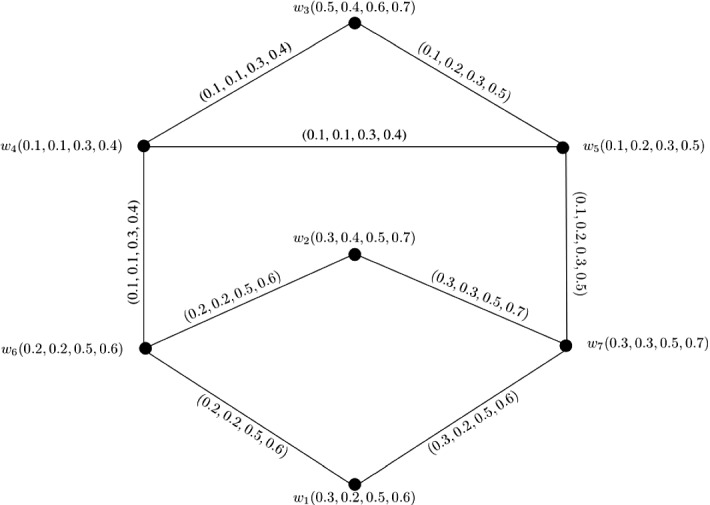
4-PF graph
Table 3.
Strength of connectivity between pairs of vertices of
| Pairs of vertices | Pairs of vertices | ||
|---|---|---|---|
| (0.3, 0.2, 0.5, 0.6) | (0.1, 0.1, 0.3, 0.4) | ||
| (0.1, 0.2, 0.3, 0.5) | (0.1, 0.2, 0.3, 0.5) | ||
| (0.1, 0.1, 0.3, 0.4) | (0.1, 0.2, 0.3, 0.5) | ||
| (0.1, 0.2, 0.3, 0.5) | (0.1, 0.2, 0.3, 0.5) | ||
| (0.2, 0.2, 0.5, 0.6) | (0.1, 0.1, 0.3, 0.4) | ||
| (0.3, 0.2, 0.5, 0.6) | (0.1, 0.1, 0.3, 0.4) | ||
| (0.1, 0.2, 0.3, 0.5) | (0.1, 0.1, 0.3, 0.4) | ||
| (0.1, 0.1, 0.3, 0.4) | (0.1, 0.2, 0.3, 0.5) | ||
| (0.1, 0.2, 0.3, 0.5) | (0.1, 0.2, 0.3, 0.5) | ||
| (0.2, 0.2, 0.5, 0.6) | (0.2, 0.2, 0.5, 0.6) | ||
| (0.3, 0.3, 0.5, 0.7) |
Here, . After calculations, we have and . Removal of certain vertices from have certain effects on . Consider (see Fig. 13). The strength of connectivity between pairs of vertices of are calculated in Table 4.
Fig. 13.
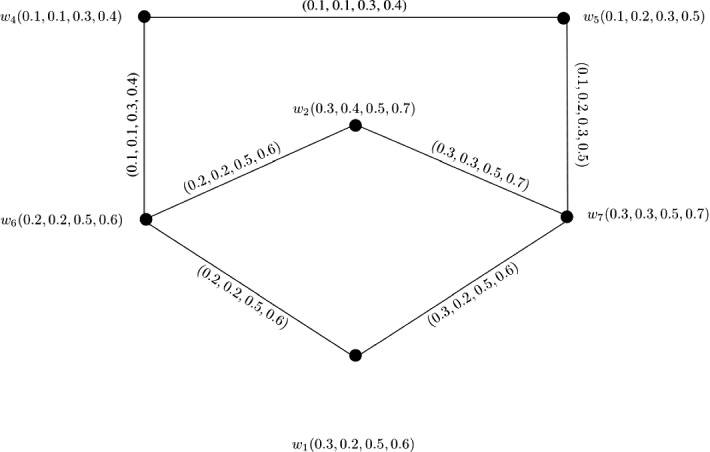
4-PF graph
Table 4.
Strength of connectivity between pairs of vertices of
| Pairs of vertices | Pairs of vertices | ||
|---|---|---|---|
| (0.3, 0.2, 0.5, 0.6) | (0.3, 0.3, 0.5, 0.7) | ||
| (0.1, 0.1, 0.3, 0.4) | (0.1, 0.1, 0.3, 0.4) | ||
| (0.1, 0.2, 0.3, 0.5) | (0.1, 0.1, 0.3, 0.4) | ||
| (0.2, 0.2, 0.5, 0.6) | (0.1, 0.1, 0.3, 0.4) | ||
| (0.3, 0.2, 0.5, 0.6) | (0.1, 0.2, 0.3, 0.5) | ||
| (0.1, 0.1, 0.3, 0.4) | (0.1, 0.2, 0.3, 0.5) | ||
| (0.1, 0.2, 0.3, 0.5) | (0.2, 0.2, 0.5, 0.6) | ||
| (0.2, 0.2, 0.5, 0.6) |
After calculations, we have and 0.181). This means that . Now, consider (see Fig. 14). The strength of connectivity between pairs of vertices of are calculated in Table 5.
Fig. 14.
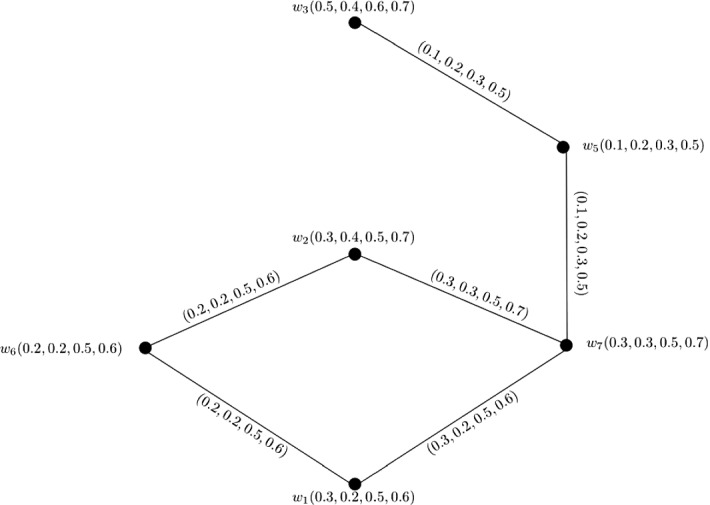
4-PF graph
Table 5.
Strength of connectivity between pairs of vertices of
| Pairs of vertices | Pairs of vertices | ||
|---|---|---|---|
| (0.3, 0.2, 0.5, 0.6) | (0.3, 0.3, 0.5, 0.7) | ||
| (0.1, 0.2, 0.3, 0.5) | (0.1, 0.2, 0.3, 0.5) | ||
| (0.1, 0.2, 0.3, 0.5) | (0.1, 0.2, 0.3, 0.5) | ||
| (0.2, 0.2, 0.5, 0.6) | (0.1, 0.2, 0.3, 0.5) | ||
| (0.3, 0.2, 0.5, 0.6) | (0.1, 0.2, 0.3, 0.5) | ||
| (0.1, 0.2, 0.3, 0.5) | (0.1, 0.2, 0.3, 0.5) | ||
| (0.1, 0.2, 0.3, 0.5) | (0.2, 0.2, 0.5, 0.6) | ||
| (0.2, 0.2, 0.5, 0.6) |
After calculations, we have and 0.090, 0.220). This means that . Similarly, the effects of deletion of different vertices on are shown in Table 6.
Table 6.
Effect on after deleting a vertex from
| Effect | |||
|---|---|---|---|
| (0.118, 0.311, 1.050, 2.734) | (0.008, 0.021, 0.070, 0.182) | Mixed | |
| (0.118, 0.253, 1.050, 2.531) | (0.008, 0.017, 0.070, 0.169) | ||
| (0.140, 0.265, 1.137, 2.713) | (0.009, 0.018, 0.076, 0.181) | ||
| (0.188, 0.356, 1.344, 3.302) | (0.013, 0.024, 0.090, 0.220) | ||
| (0.118, 0.244, 1.344, 2.823) | (0.013, 0.016, 0.090, 0.188) | Mixed | |
| (0.154, 0.307, 1.050, 2.709) | (0.010, 0.020, 0.070, 0.181) | Mixed | |
| (0.109, 0.118, 1.050, 2.303) | (0.007, 0.008, 0.070, 0.154) |
Clearly, the vertices , , are 4-PFCRVs, vertex is 4-PFCEV and vertices , , are 4-PFCMVs. Note that if company do not manufacture any one of the products , and then its profit will decrease, if company do not manufacture product then its profit will increase and if company do not manufacture any one of the products , , then there will be mixed change in its profit. Thus, it is sufficient to manufacture the products Prod-II, Prod-III and Prod-VII for minimizing time consumption, earning more profit, attracting a wide range of all classes of people and minimizing cost. The comparison between and for is analyzed using the bar charts in Fig. 15.
Fig. 15.
Comparison of and for .
We now describe the general procedure adopted in our application.
-
Step 1.
Input the set of vertices (products) .
-
Step 2.
Input the m-PF set of vertices such that
-
Step 3.
Input the set of edges (relationship between products) for ; .
-
Step 4.Input the m-PF relation of vertices such that , where
for each and for ; . -
Step 5.
Construct the m-PF graph .
-
Step 6.Find the strength of connectedness between all pairs of vertices and of such that , where
for each . -
Step 7.Compute the such that
for each . -
Step 8.Compute the such that
for each . -
Step 9.
Consider the m-PF subgraph of by deleting a vertex from .
-
Step 10.
Compute the and .
-
Step 11.
Compare the and .
-
Step 12.Output :
- If for each then is m-PFCRV.
- If for each then is m-PFCEV.
- If for each then is m-PFCNV.
-
Step 13.
Repeat steps 9-12 for all vertices .
-
Step 14.
m-PFCRVs are preferable here to manufacture by ignoring the other vertices.
Comparative analysis
m-PF graphs have numerous applications in decision-making issues when it is compulsory to make decisions with a group of individuals or agreements. The membership value of an element in an m-PF set belongs to , which exhibits all the m different qualities of the object. This is better suited to a variety of real-world uncertain issues when data originates from several agents, resulting in multi-polar information that fuzzy sets and bipolar fuzzy sets cannot accurately express. In this section, we discuss the problem of selecting the set of representatives for a youth development council (YDC) in a university using the fuzzy graph model, bipolar fuzzy graph model and m-PF graph model to demonstrate the flexibility and validity of our suggested approach.
Finding the set of representatives through fuzzy graph
We consider a set of students Hamza, Suleman, Waris, Uzaifa who want to become a member of YDC. We wish to form a YDC with the fewest possible members. We want to build a YDC in which every member who is not in the council has something in common with those who are. Each student has some good leadership qualities such as approachable, good communicator, good listener, honest and fair. All these qualities are uncertain in nature. Therefore, fuzziness can be added to represent this problem. A fuzzy graph model of this problem is given in Fig. 16, taking W as the set of vertices. The membership value of each student represents the degree of having good leadership qualities. For example, Hamza means that Hamza has good leadership qualities. The edge between two students represents the degree of having common good leadership qualities. For example, Hamza, Waris means that Hamza and Waris have good leadership qualities in common.
Fig. 16.

Fuzzy graph
The strength of connectivity between pairs of vertices of fuzzy graph are calculated in Table 7.
Table 7.
Strength of connectivity between pairs of vertices of
| Pairs of vertices | |
|---|---|
| 0.5 | |
| 0.6 | |
| 0.5 | |
| 0.5 | |
| 0.5 | |
| 0.5 |
After calculations, we have and . The and for are calculated in Table 8. The effects of elimination of different vertices on are shown in Fig. 17.
Table 8.
after deleting a vertex from
| 0.600 | 0.200 | |
| 0.714 | 0.238 | |
| 0.480 | 0.160 | |
| 0.714 | 0.238 |
Fig. 17.
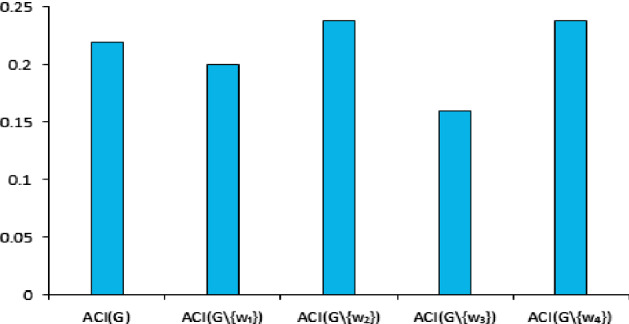
Comparison of and for
Therefore, and should be the members of YDC.
Finding the set of representatives through bipolar fuzzy graph
Each student has some bad leadership qualities such as lack of enthusiasm, incompetency, poor decision-making and inflexibility. All these qualities are also uncertain in nature. Therefore, fuzziness can be added. A fuzzy graph model fails to illustrate bad leadership qualities along with good leadership qualities. A bipolar fuzzy graph model (Akram 2011) of this problem is given in Fig. 18, taking W as the set of vertices. The membership value of each student represents the degree of having good leadership qualities and having bad leadership qualities. For example, Hamza means that Hamza has good leadership qualities and bad leadership qualities. The edge between two students represents the degree of having common good leadership qualities and having common bad leadership qualities. For example, Hamza, Waris means that Hamza and Waris have good leadership qualities in common and bad leadership qualities in common.
Fig. 18.
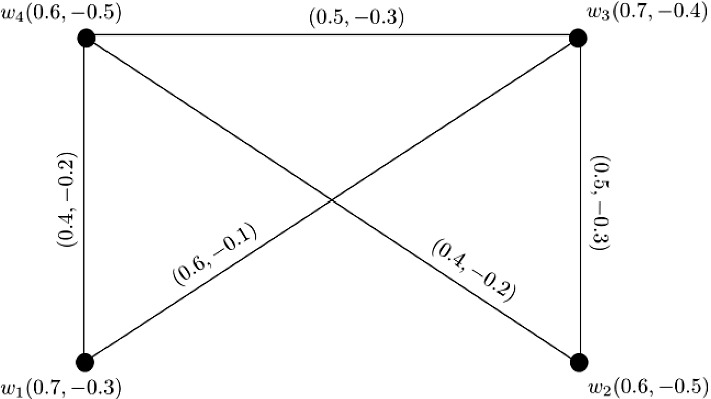
Bipolar fuzzy graph
The strength of connectivity between pairs of vertices of bipolar fuzzy graph are calculated in Table 9.
Table 9.
Strength of connectivity between pairs of vertices of
| Pairs of vertices | |
|---|---|
After calculations, we have and . The and for are calculated in Table 10. The effects of deletion of different vertices on is shown in Fig. 19.
Table 10.
after deleting a vertex from
Fig. 19.
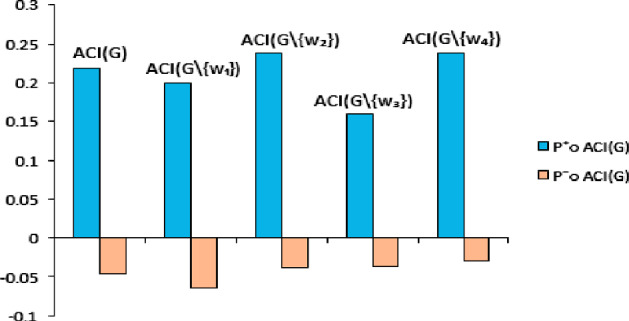
Comparison of and for
Therefore, should be the member of YDC.
Finding the set of representatives through m-PF graph
Note that fuzzy graph model just illustrate the overall good leadership qualities of the students. On the other hand, bipolar fuzzy graph model can illustrate the overall good leadership qualities along with the overall bad leadership qualities of the students. But, both these graph models are unable to deal with leadership qualities one by one as good leadership qualities are characterized by good communicator, approachable etc while bad leadership qualities are characterized by lack of enthusiasm, incompetency etc. Since, all these qualities are uncertain in nature. Therefore, we can associate the degree of membership value according to each single leadership quality. Fuzzy graph model and bipolar fuzzy graph model fail to handle this situation. To handle such type of problem, m-PF graph model is given in Fig. 20, taking W as the set of vertices. The membership value of each student represents the degree of communication skills, honesty, decision-making and incompetency. The description of the students can be expressed as in the following set:
Fig. 20.
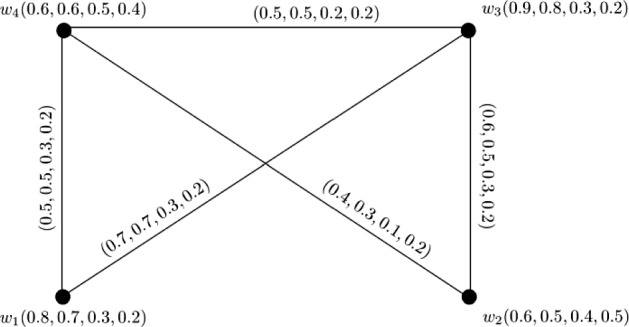
m-PF graph
Communicator, Honest, Decision-maker, Incompetent.
For example, Hamza means that Hamza is good communicator, honest, good decision-maker and incompetent. The edge between two students represents the degree of common good communication skills, honesty, good decision-making and incompetency. For example, Hamza, Waris means that Hamza and Waris have common good communicating skills, common honesty, common good decision-making and common incompetency.
The strength of connectivity between pairs of vertices of m-PF graph are calculated in Table 11.
Table 11.
Strength of connectivity between pairs of vertices of
| Pairs of vertices | |
|---|---|
| (0.6, 0.5, 0.3, 0.2) | |
| (0.7, 0.7, 0.3, 0.2) | |
| (0.5, 0.5, 0.3, 0.2) | |
| (0.6, 0.5, 0.3, 0.2) | |
| (0.5, 0.5, 0.3, 0.2) | |
| (0.5, 0.5, 0.3, 0.2) |
After calculations, we have and . The and for are calculated in Table 12. The effects of deletion of different vertices on is shown in Fig. 21.
Table 12.
after deleting a vertex from
| (0.774, 0.590, 0.106, 0.076) | (0.258, 0.197, 0.035, 0.025) | |
| (1.014, 0.842, 0.117, 0.040) | (0.338, 0.281, 0.039, 0.013) | |
| (0.576, 0.405, 0.077, 0.076) | (0.192, 0.135, 0.026, 0.025) | |
| (1.890, 1.357, 0.240, 0.124) | (0.630, 0.452, 0.080, 0.041) |
Fig. 21.
Comparison of and for
Therefore, both and should be the members of YDC. The feasibility and applicability of our proposed model is shown in Table 13.
Table 13.
Comparative analysis
| Model | Description | Property | Range | ACI(G) | Output | ||
|---|---|---|---|---|---|---|---|
| 0.200 | |||||||
| Fuzzy graph | Describes single | Good leadership qualities | [0, 1] | 0.219 | 0.238 | & should be | |
| property of elements | 0.160 | the member of | |||||
| 0.238 | YDC | ||||||
| Bipolar fuzzy graph | Describes single property | {Good leadership qualities, | should be | ||||
| with counter single | Bad leadership qualities} | the member of | |||||
| property of elements | YDC | ||||||
| (0.258, 0.197, 0.035, 0.025) | |||||||
| m-PF graph | Describes more than | {Communication skills, | (0.301, 0.228, 0.042, 0.020) | (0.338, 0.281, 0.039, 0.013) | & should be | ||
| one property of elements | Honesty, Decision-making | here, | (0.192, 0.135, 0.026, 0.025) | the member of | |||
| skills, Incompetency} | (0.630, 0.452, 0.080, 0.041) | YDC |
Benefits and limitations of the proposed method
The investigations above lead us to believe that the proposed connectivity analysis for m-PF networks may be employed efficiently to give accurate assessments of certain aspects of uncertain information. Let us summarize some of the advantages of the proposed research work:
Connectivity analysis of m-PF networks enables us to apply connectivity and average connectivity indices in multi-polar uncertain real-world issues, resulting in precise solutions for more flexible graph-theoretical problems.
The cornerstone of our model is a multi-component membership assessment. It gives us a unified expression for the adequacy of each alternative in relation with a fixed list of characteristics.
Because various qualities of objects are captured by one proxy, more accurate information is available to perform operations conducive to well grounded decisions.
Besides these advantages, we should be aware of the limitations of proposed method.
Although the connectivity index and average connectivity index can be used to determine the stability of an m-PF graph, the simultaneous comparison of numerous attributes can make it tough to achieve fully convincing selections.
The proposed model delivers flexible outcomes, however it is difficult to manage multi-components of membership values in the case of large datasets, as they impose a computational burden and increase complexity.
Conclusion and future directions
One of the key factors affecting a network is connectivity. In this article, two distinct network parameters, namely, the connectivity index and average connectivity index, are described for m-PF graphs. These indices permit to evaluate the stability of a m-PF network. Characterizations for various kinds of m-PF graphs are obtained. Specifically, the effects of deleting a vertex or an edge in m-PF graphs, and the bounds in the case of specific m-PF graphs, are analyzed. Algorithms related to these concepts are given. The results that have been obtained can be helpful in the quantitative inspection of human trafficking, Internet routing, etc. In order to demonstrate and validate the proposed algorithm, our work has provided useful tools for a more efficient application of m-PF graphs in practice. We have applied them in a particular product manufacturing problem, and explained it with reference to a general algorithm designed to easily understand the method. Finally, we have provided a comparative analysis to prove the feasibility and validity of proposed method. Thus, our approach may offer flexible solutions to several graph-theoretical multi-polar uncertain real-world scenarios by managing multi-components of the membership values for large datasets.
This research work can be further extended to include the analysis of (1) Operators and algorithms to efficiently handle multi-polarity; (2) Connectivity indices of m-PF rough graphs; (3) Cyclic connectivity index of m-PF graphs; (4) Average cyclic connectivity index of m-PF graphs; (5) Wiener index of m-PF graphs.
Acknowledgements
Alcantud is grateful to the Junta de Castilla y León and the European Regional Development Fund (Grant CLU-2019-03) for the financial support to the Research Unit of Excellence “Economic Management for Sustainability” (GECOS).
Funding
Open Access funding provided thanks to the CRUE-CSIC agreement with Springer Nature.
Delarations
Data availability
No data were used to support this study.
Conflict of interest
The authors declare no conflict of interest.
Footnotes
Publisher's Note
Springer Nature remains neutral with regard to jurisdictional claims in published maps and institutional affiliations.
Contributor Information
Muhammad Akram, Email: m.akram@pucit.edu.pk.
Saba Siddique, Email: sabasabiha6@gmail.com.
José Carlos R. Alcantud, Email: jcr@usal.es
References
- Akram M. Bipolar fuzzy graphs. Inf Sci. 2011;181(24):5548–5564. doi: 10.1016/j.ins.2011.07.037. [DOI] [Google Scholar]
- Akram M, Adeel A. -polar fuzzy labeling graphs with application. Math Comput Sci. 2016;10:387–402. doi: 10.1007/s11786-016-0277-x. [DOI] [Google Scholar]
- Akram M, Nawaz HS. Implementation of single-valued neutrosophic soft hypergraphs on human nervous system. Artif Intell Rev. 2022 doi: 10.1007/s10462-022-10200-w. [DOI] [Google Scholar]
- Akram M, Sarwar M. Novel applications of -polar fuzzy graphs in decision support systems. Neural Comput Appl. 2017;30:3145–3165. doi: 10.1007/s00521-017-2894-y. [DOI] [Google Scholar]
- Akram M, Waseem N. Certain metrics in -polar fuzzy graphs. New Math Nat Comput. 2016;12:135–155. doi: 10.1142/S1793005716500101. [DOI] [Google Scholar]
- Akram M, Akmal R, Alshehri N. On -polar fuzzy graph structures. Springerplus. 2016;5:1448–1467. doi: 10.1186/s40064-016-3066-8. [DOI] [PMC free article] [PubMed] [Google Scholar]
- Akram M, Waseem N, Dudek WA. Certain types of edge -polar fuzzy graphs. Iran J Fuzzy Syst. 2017;14(4):27–50. [Google Scholar]
- Akram M, Siddique S, Ahmad U. Menger’s theorem for -polar fuzzy graphs and application of -polar fuzzy edges to road network. J Intell Fuzzy Syst. 2021;41(1):1553–1574. doi: 10.3233/JIFS-210411. [DOI] [Google Scholar]
- Ali S, Mathew S, Mordeson JN, Rashmanlou H. Vertex connectivity of fuzzy graphs with applications to human trafficking. New Math Nat Comput. 2018;14(03):457–485. doi: 10.1142/S1793005718500278. [DOI] [Google Scholar]
- Banerjee S. An optimal algorithm to find the degrees of connectedness in an undirected edge-weighted graph. Pattern Recogn Lett. 1991;12:421–424. doi: 10.1016/0167-8655(91)90316-E. [DOI] [Google Scholar]
- Bhattacharya P. Some remarks on fuzzy graphs. Pattern Recogn Lett. 1987;6:297–302. doi: 10.1016/0167-8655(87)90012-2. [DOI] [Google Scholar]
- Bhattacharya P, Suraweera F. An algorithm to compute the supremum of max-min powers and a property of fuzzy graphs. Pattern Recogn Lett. 1991;12:413–420. doi: 10.1016/0167-8655(91)90307-8. [DOI] [Google Scholar]
- Bhutani KR, Rosenfeld A. Strong arcs in fuzzy graphs. Inf Sci. 2003;152:319–322. doi: 10.1016/S0020-0255(02)00411-5. [DOI] [Google Scholar]
- Binu M, Mathew S, Mordeson J. Connectivity index of a fuzzy graph and its application to human trafficking. Fuzzy Sets Syst. 2019;360:117–136. doi: 10.1016/j.fss.2018.06.007. [DOI] [Google Scholar]
- Binu M, Mathew S, Mordeson JN. Connectivity status of fuzzy graphs. Inf Sci. 2021;573:382–395. doi: 10.1016/j.ins.2021.05.068. [DOI] [Google Scholar]
- Chen SM. Interval-valued fuzzy hypergraph and fuzzy partition. IEEE Trans Syst Man Cybern (Cybernetics) 1997;27(4):725–733. doi: 10.1109/3477.604121. [DOI] [PubMed] [Google Scholar]
- Chen J, Li S, Ma S, Wang X. -polar fuzzy sets: an extension of bipolar fuzzy sets. Sci World J. 2014;2014:1–8. doi: 10.1155/2014/416530. [DOI] [PMC free article] [PubMed] [Google Scholar]
- Gao W, Chen Y, Zhang Y. Viewing the network parameters and -factors from the perspective of geometry. Int J Intell Syst. 2022 doi: 10.1002/int.22859. [DOI] [Google Scholar]
- Gao W, Yan L, Li Y, Yang B. Network performance analysis from binding number prospect. J Ambient Intell Humaniz Comput. 2022;13:1259–1267. doi: 10.1007/s12652-020-02553-3. [DOI] [Google Scholar]
- Ghorai G, Pal M. Faces and dual of -polar fuzzy planner graphs. J Intell Fuzzy Syst. 2016;31:2043–2049. doi: 10.3233/JIFS-16433. [DOI] [Google Scholar]
- Ghorai G, Pal M. Some isomorphic properties of -polar fuzzy graphs with applications. Springerplus. 2016;5:2104–2125. doi: 10.1186/s40064-016-3783-z. [DOI] [PMC free article] [PubMed] [Google Scholar]
- Gong S, Hua G, Gao W. Domination of bipolar fuzzy graphs in various settings. Int J Comput Intell Syst. 2021;14:162–175. doi: 10.1007/s44196-021-00011-2. [DOI] [Google Scholar]
- Habib A, Akram M, Kahraman C. Minimum spanning tree hierarchical clustering algorithm: a new Pythagorean fuzzy similarity measure for the analysis of functional brain networks. Expert Syst Appl. 2022;201:117016. doi: 10.1016/j.eswa.2022.117016. [DOI] [Google Scholar]
- Jicy N, Mathew S. Connectivity analysis of cyclically balanced fuzzy graphs. Fuzzy Inf Eng. 2015;7(2):245–255. doi: 10.1016/j.fiae.2015.05.008. [DOI] [Google Scholar]
- Kaufmann A (1973) Introduction à la Théorie des Sous-ensembles Flous. Mason et Cie
- Mahapatra T, Pal M. Fuzzy colouring of -polar fuzzy graph and its application. J Intell Fuzzy Syst. 2018;35(6):6379–6391. doi: 10.3233/JIFS-181262. [DOI] [Google Scholar]
- Mahapatra T, Pal M. An investigation on -polar fuzzy threshold graph and its application on resource power controlling system. J Ambient Intell Hum Comput. 2022;13:501–514. doi: 10.1007/s12652-021-02914-6. [DOI] [Google Scholar]
- Mahapatra T, Sahoo S, Ghorai G, Pal M. Interval valued m-polar fuzzy planar graph and its application. Artif Intell Rev. 2021;54:1649–1675. doi: 10.1007/s10462-020-09879-6. [DOI] [Google Scholar]
- Mandal S, Sahoo S, Ghorai G, Pal M. Application of strong arcs in -polar fuzzy graphs. Neural Process Lett. 2018;50:771–784. doi: 10.1007/s11063-018-9934-1. [DOI] [Google Scholar]
- Mathew S, Sunitha MS. Types of arcs in a fuzzy graph. Inf Sci. 2009;179:1760–1768. doi: 10.1016/j.ins.2009.01.003. [DOI] [Google Scholar]
- Mathew S, Sunitha MS. Cycle connectivity in fuzzy graphs. J Intell Fuzzy Syst. 2013;24(3):549–554. doi: 10.3233/IFS-2012-0573. [DOI] [Google Scholar]
- Mordeson JN, Nair PS (2000) Fuzzy graphs and fuzzy hypergraphs, 2nd ed. Physica Verlag, Heidelberg, 1998. Studies in fuzziness and soft computing; Springer. 10.1007/978-3-7908-1854-3
- Naeem T, Gumaei A, Kamran Jamil M, Alsanad A, Ullah K. Connectivity indices of intuitionistic fuzzy graphs and their applications in internet routing and transport network flow. Math Probl Eng. 2021 doi: 10.1155/2021/4156879. [DOI] [Google Scholar]
- Poulik S, Ghorai G. Certain indices of graphs under bipolar fuzzy environment with applications. Soft Comput. 2020;24:5119–5131. doi: 10.1007/s00500-019-04265-z. [DOI] [Google Scholar]
- Rosenfeld A. Fuzzy graphs, fuzzy sets and their applications. New York: Academic Press; 1975. pp. 77–95. [Google Scholar]
- Samanta S, Pal M. Fuzzy planar graphs. IEEE Trans Fuzzy Syst. 2015;23(6):1936–1942. doi: 10.1109/TFUZZ.2014.2387875. [DOI] [Google Scholar]
- Tong Z, Zheng D. An algorithm for finding the connectedness matrix of a fuzzy graph. Congr Numer. 1996;120:189–192. [Google Scholar]
- Xu J. The use of fuzzy graphs in chemical structure research. In: Rouvry DH, editor. Fuzzy logic in chemistry. New York: Academic Press; 1997. pp. 249–282. [Google Scholar]
- Yeh RT, Bang SY. Fuzzy relations, fuzzy graphs and their applications to clustering analysis. In: Zadeh LA, Fu KS, Tanaka K, Shimura M, editors. fuzzy sets and their applications to cognitive and decision process. New York: Academic Press; 1975. pp. 125–149. [Google Scholar]
- Zadeh LA. Fuzzy sets. Inf. Control. 1965;8(3):338–353. doi: 10.1016/S0019-9958(65)90241-X. [DOI] [Google Scholar]
- Zhang WR (1994) Bipolar fuzzy sets and relations: a computational framework for cognitive modeling and multiagent decision analysis. In: Proceedings of IEEE conference fuzzy information processing society biannual conference, pp 305–309
Associated Data
This section collects any data citations, data availability statements, or supplementary materials included in this article.
Data Availability Statement
No data were used to support this study.





